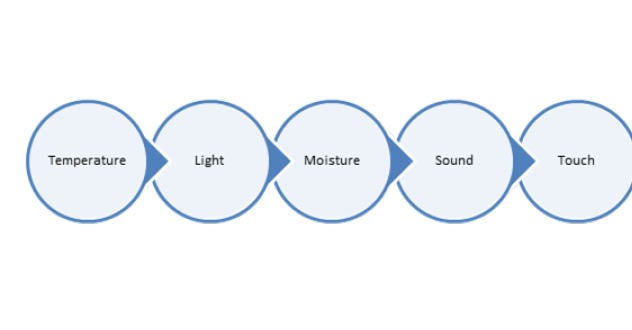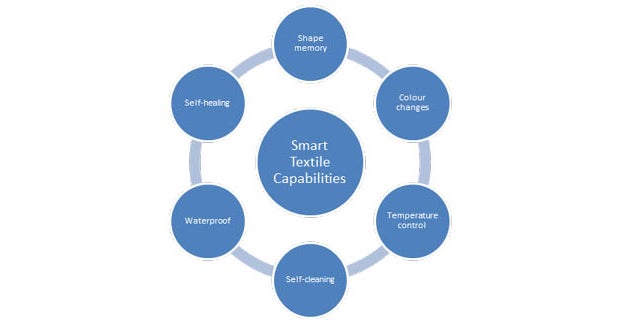Wearable technology is increasingly becoming part of our daily routines. Accessories like smart watches and glasses help us to send messages, track our steps and read the news. But what if other parts of our outfit could have the same features?
Smart fabrics hit the headlines when Claire Danes stepped out at the Met Gala in a Zac Posen dress made from a fiber optic woven organza.

But smart textiles can be used for more than just Met Gala showstoppers or striking visual effects. The range of external stimuli that can be detected by smart textiles means that these materials have practical application across a broad spectrum of industries. Fabrics are being developed with inbuilt sensors in order to improve the quality of medical care, ease the daily commute and boost athletic performance.
What are smart textiles?
Smart textiles are adaptive fabrics that contain systems capable of observing, detecting and responding to the wearer’s environment. Changes to the environment cover a range of stimuli, including:

Different sensors at different locations can provide insights about the wearer’s health, performance and wellbeing.
When smart textiles pick up on variations in any of these external stimuli, the garment will adapt to the new environment. For example, photochromic fabrics change colours when they are exposed to a new light source, or thermal-regulating fabrics can dissipate heat emitted from the body to cool you down. These responsive elements are integrated into the fibres of the fabric through coatings, films, weaving, braiding or knitting processes.

The University of Cambridge predicted that the market for wearable products using smart textiles will reach US$70 billion this year, and will develop in the direction of lightweight, fashionable, personalized, low-cost and with communication functions.
The universality of clothing makes it an ideal canvas for innovation and transformation. Ruckdashel, Venkataraman and Park noted:
Clothing is a great platform for “smart” functionalities because it is ubiquitous, worn by everyone, covers a large percentage of the human body, and is form-fitting for direct skin contact.
However, the wearability of clothing means that smart textiles need to incorporate all the other characteristics we expect from our clothing such as comfort, durability, tactility and, of course, the overall appearance.
Wearable computers vs smart textiles
Unlike smart watches or other gadgets, smart textiles do not need to be switched on or off. They function through a combination of sensors, which detect stimuli, and actuators, which act upon this data. This means the technology is always accessible based on explicit input (such as a voice command) or implicit input (such as a change in heart rate).
Also, because the functionality is built into the base structure of the garment, there is no need for wires or circuit boards. This allows the fabric to remain flexible and comfortable with unnoticeable technology. For example, to incorporate UV protective qualities, materials such as optical brighteners and UV absorbers are added to the fabric which can help prevent skin damage as a result of sun exposure.
What smart fabrics can do
Smart textiles provide several opportunities:
- Sustainability: According to a McKinsey report, three out of five garments end up in a landfill or incinerated each year. Shoppers are turning away from fast fashion and towards sustainable fashion that can be reworn and repurposed in order to extend the lifespan of the garment. The multi-functionality of smart textiles can reduce the environmental impact of the textile industry.
- Proactive: The dynamic functions of smart textiles can anticipate and mitigate changes in environment such that a jacket adjust its ventilation capacity before you start sweating or indicate the presence of a contaminant before it reaches dangerous levels.
- Remote results: Smart textiles in the health sector can improve patient monitoring and the availability of telehealth services. From the comfort of your home, medical professionals can offer remote diagnosis based on accurate, real-time patient data and reduce the time spent waiting in medical centres for test results.
- Easy to maintain: Garments made from smart textiles are able to be washed, folded and maintained without adding any additional burden to laundry day. In fact, some smart textiles can even clean themselves by removing any dirty particles through rolling water droplets or light decomposition.
Case studies
High-tech healthcare and PPE
Ruckdashel, Venkataraman and Park observed that smart textiles are “uniquely suited to healing applications because they require functionalizing surfaces which already in use: textiles such as bandages, scaffolds, and sutures”. Following the COVID-19 pandemic, smart textiles have the capacity to transform personal protective equipment (PPE) and masks to be more accessible, comfortable and functional.
Smart textiles in the medical industry can be divided into two main categories:
- diagnostic and monitoring textiles can provide real-time information about a patient’s biometric data. Vital signs that can be monitored by this technology include glucose levels, blood pressure, sleep cycles and one study used smart sensors to correct bad posture. Smart textiles provide real-time tracking that can be used to alert the patient by changing colour or setting off an alert before a life-threatening event such as a stroke or heart attack.
- therapeutic textiles offer an alternative to pain management, physiotherapy and wound care. Augmented band-aids or bandages can offer improved drug delivery through the direct contact between a patient’s skin and the smart textile. Smart textiles provide a user-friendly, non-invasive solution to improving the quality of care and treatment in the health care sector.
Jack-et of all trades
Google teamed up with Levi’s to design a smart denim jacket with all the bells and whistles woven in. The Jacquard jacket is made from conductive yarn, transforming this wardrobe staple into an interactive surface. By tapping, swiping or holding the jacket cuff, you can answer phone calls, take a selfie or pause a song. The Commuter jacket, specifically designed for city cyclists, incorporates lights to alert the wearer of incoming texts and get directions on the go.
Similarly, the HugShirt uses haptic telecommunications to recreate the feeling of a hug. Bringing together smart textiles and human interaction, the HugShirt can bring you closer to a loved one anywhere in the world without even having to book a flight. Multiple sensors embedded in the shirt record the strength, duration, and location of the touch in order to replicate the unique style of hug.
Athlete’s foot
Whether you’re a training for a marathon or a 5k fun run, smart textiles can assist with detecting dehydration, reducing injury and measuring your performance on your next run.
Sensoria designed Smart Socks using textile sensors to detect cadence, foot landing, and impact forces. Coupled with a mobile app, these socks help runners identify certain bad habits that make them more injury-prone such as heel striking or ball striking and will suggest real-time auditory cues to get the runner back on track.
Smart textiles introduce data points without having to interfere with the natural movement of the athlete. WearableX have paved the way for high-performance leggings and sports apparel that provides yogis with guidance as they work through their flow. Small pulses or vibrations around the hips, ankles and knees provide instant feedback to ensure you have perfect form as you transition from pose to pose.
Where next?
Smart textiles also present new challenges for textile designers as well as other industries such as nanotechnology and computer engineering:
- Production: Novel materials and printing techniques require additional capacity to manufacture smart textile technology on a larger scale – and at an accessible price point.
- Integration: Part of the is streamlining the integration and interface between smart textiles and other devices. Collaborations with digital innovators including Microsoft, Google and Apple can provide multiplatform functionality.
- Privacy: As we accrue more data points, particularly relating to personal health, important policy questions need to be considered about how this information is protected and shared

Visit Smart Counsel
